Shimoda offers an extensive range of padded Core Units to fit its camera bags. The Shimoda standard Core Units are designed to be paired with the Shimoda Explore V2 backpack, the Shimoda Action X V2 backpack, the Shimoda Urban Explore backpack, the Shimoda Carry-On Roller, or the DV roller. The range of Soft Cores and Drone Cores are sized to fit all of those same packs, as well as the Side Series bags: Sidecountry, Side Lite, and Side Street. Even if you have a camera bag not made by Shimoda, the wide range of Core Unit sizes ensures one will fit.
In this post, we’ll closely examine every size to help you determine which one would be right for you. Of course, being cubic padded camera cases, nothing stops you from using these to convert other types of bags into camera bags. The photos and dimensions in this guide will also help people with that choice.
Shimoda Designs has offered Shutter Muse readers a 10% discount on anything purchased through their online stores. US, Canadian, UK, French, or German residents should use the discount code ShutterMuse10 after clicking here to access the store. Australian readers should use the same code on the local Shimoda distributor’s site, Maxxum, instead.
Table of Contents
Core Unit Construction
Over the years, I have amassed a vast collection of camera inserts from various manufacturers. The Shimoda Design Core Units stand out from the crowd because of the bright color and the considerably different direction they have taken with the construction.
While most camera inserts from brands such as F-Stop, Lowepro, and Think Tank Photo are relatively soft and lightweight, Shimoda has gone in the opposite direction for their series of standard Core Units. Each standard Core Unit features an internal frame, with the side panels and internal dividers having good rigidity.


There are two reasons for this. Firstly, the rigidity of the Shimoda Core Units gives shape and rigidity to the Explore and Action X backpacks themselves. Secondly, by using a tougher construction on the Core Unit walls and dividers, those walls and dividers can be much thinner than the padding on most other camera inserts. And they do this while maintaining plenty of protection for the gear stored within. The result is that standard Shimoda Core Units offer more protection than other camera inserts, and less of a bag’s internal volume is consumed by thick padding.
One thing to be aware of is that you have to take the time to customize the layout of the Core Units to your gear. With camera inserts that use thicker, more flexible dividers, each slot you create has a certain amount of “give” to it. If a slot is too small for a lens, you can squeeze it in, and the padding will flex to accommodate it.
That’s not the case with the standard Shimoda Core Units. The dividers are covered in a soft material but are not as soft as you might expect. This means that it’s hard to squeeze a larger lens into a too-small hole. It also means that a lens placed in a too-big hole will tend to rattle around more than in softer camera inserts. The best way to use these units is to take the time to customize them carefully to your kit.


Core Unit Covers


Every standard Shimoda Core Unit comes in a lightweight nylon zippered cover. If you use your Core Unit to store gear in your closet at home, the cover is excellent for keeping the dust off your equipment. Alternatively, you can use the cover as a packing cube while traveling, either in your checked duffle or your Shimoda bag.
Finally, the cover is also helpful if you have a Core Unit in your bag with a shallower depth than the bag itself. Shimoda’s bags are designed to have a depth to match specific Core Units. But it is still possible to use a shallower Core Unit. When you do this, there will be extra space within the bag. Without the cover over the Core Unit, your cameras and lenses can move around too much and potentially fall into the bag’s main section.
Shimoda Core Unit Dimensions
Below is a list of dimensions and specifications for all current models of the Shimoda Core Unit.
Standard Core Units
| Shimoda Core Unit | Width Internal | Height Internal | Depth Internal | Width External | Height External | Depth External | Weight |
|---|---|---|---|---|---|---|---|
| XS25 | 9.4in / 24cm | 7.5in / 19cm | 4.7in / 12cm | 10.2in / 26cm | 8.3in / 21cm | 5.1in / 13cm | 0.7lbs / 0.34kg |
| S25 | 9.4in / 24cm | 11in / 28cm | 4.7in / 12cm | 10.2in / 26cm | 11.8in / 30cm | 5.1 in / 13cm | 1lbs/0.45kg |
| L25 RST | 9.4in / 24cm | 16.9in / 43cm | 4.7in / 12cm | 10.2in / 26cm | 17.5in / 45cm | 5.1in / 13cm | 1.2lbs / 0.56kg |
| Medium Mirrorless | 10.6in / 27cm | 10.6in / 27cm | 4.7in / 12cm | 11.4in / 29cm | 11.4in / 29cm | 5.1in / 13cm | 1.1lbs / 0.5kg |
| Large Mirrorless | 10.6in / 27cm | 14.6in / 37cm | 4.7in / 12cm | 11.4in / 29cm | 15.4in / 39cm | 5.1in / 13cm | 1.7lbs / 0.77kg |
| XL30 RST | 10.2in / 26cm | 18.1in / 46cm | 4.7in / 12cm | 11in / 28cm | 18.9in / 48cm | 5.1in / 13cm | 1.4lbs / 0.64kg |
| Small DSLR | 10.6in / 27cm | 4.1in / 10.5cm | 6.3in / 16cm | 11.4in / 29cm | 4.7in / 12cm | 6.7in / 17cm | 0.58lb / 0.29kg |
| Medium DSLR V2 | 10.6in / 27cm | 10.6in / 27cm | 6.7in / 17cm | 11.4in / 29cm | 11.4in / 29cm | 7in / 18cm | 1.3lbs / 0.6kg |
| Large DSLR V3 | 10.6in / 27cm | 15.7″ / 40cm | 6.7in / 17cm | 11.4in / 29cm | 16.5in / 42cm | 7in / 18cm | 2.2lbs / 1.02kg |
| XL40 RST | 10.2in / 26cm | 19.7in / 50cm | 6.1 in / 15.5cm | 11in / 28cm | 20.5in / 52cm | 6.5in / 16.5cm | 2lbs / 0.92kg |
| XL50 RST | 10.2in / 26cm | 20.9in / 53cm | 6.1 in / 15.5cm | 11in / 28cm | 21.7in / 55cm | 6.5in / 16.5cm | 2.1lbs / 0.95kg |
| Large DV V2 | 11.4″ / 29cm | 15.7″ / 40cm | 7.9in / 20cm | 12.2″ / 31cm | 16.5in / 42cm | 8.3″ / 21cm | 2.6lbs / 1.2kg |
| Extra-Large DV V2 | 11.4″ / 29cm | 18.9″ / 48cm | 7.9in / 20cm | 12.2″ / 31cm | 19.7″ / 50cm | 8.3″ / 21cm | 3.1lbs / 1.39kg |
| Extra-Extra-Large DV | 11.4″ / 29cm | 21.7″ / 55cm | 7.9in / 20cm | 12.2″ / 31cm | 22.5″ / 57cm | 8.3″ / 21cm | 2.9lbs / 1.33kg |
Urban Explore Core Units
Shimoda’s Urban Explore backpacks come with bespoke Core Units. These Core Units are unavailable for separate purchases, so Shimoda does not list their weights.
| UE Core Unit | Width | Height | Depth |
|---|---|---|---|
| Urban Explore 20 | 7.9″ / 20cm | 10.6″ / 27cm | 5.1″/ 13cm |
| Urban Explore 25 | 9″ / 23cm | 10.6″ / 27cm | 5.1″ / 13cm |
| Urban Explore 30 | 10.2″ / 26cm | 13″ / 33cm | 5.1″ / 13cm |
Soft Core Units
Shimoda’s range of Soft Core Units is ideal for protecting compact vlogging setups or accessory organization. Use them in place of a standard Core Unit, or stack them in your bag on top of an existing hard-side standard Core Unit.
| Model | Width Internal | Height Internal | Depth Internal | Width External | Height External | Depth External | Weight |
|---|---|---|---|---|---|---|---|
| Soft Small | 8.7in / 22cm | 4.9in / 12.5cm | 3.3in / 8.5cm | 9.3in / 23.5cm | 5.5in / 14cm | 3.9in / 10cm | 0.5lbs / 0.21kg |
| Soft Medium | 9.4in / 24cm | 6.3in / 16cm | 3.3in / 8.5cm | 10in / 25.5cm | 6.9in / 17.5cm | 3.9in / 10cm | 0.6lbs / 26kg |
| Soft Large | 10.4in / 26.5cm | 7.3in / 18.5cm | 3.3in / 8.5cm | 11in / 28cm | 7.9in / 20cm | 3.9in / 10cm | 0.7lbs / 0.31kg |
Drone Core Units
The clue is in the name. These are soft-sided Core Units sized for small drones like a Mavic Mini, Mavic Air, or larger drones like the Mavic 3 or 4. They are great for stacking on top of standard Core Units in your Shimoda camera bag, or for protecting your drone in any non-Shimoda pack.
| Model | Width Internal | Height Internal | Depth Internal | Width External | Height External | Depth External | Weight |
|---|---|---|---|---|---|---|---|
| Drone Mini | 9.4in / 24cm | 6.7in / 17cm | 3.1in / 8cm | 10.2in / 26cm | 7.1in / 18cm | 3.9in / 10cm | 0.6lbs / 0.25kg |
| Drone Pro | 9.6in / 24.5cm | 6.5in / 16.5cm | 5.9in / 15cm | 10.2in / 26cm | 7.1in / 18cm | 6.5in / 16.5cm | 0.8lbs / 0.35kg |
Deprecated Core Units
The following specifications are for Core Unit sizes that are no longer manufactured. I include them for existing owners who want to compare what they own to other available sizes.
| Old Core Unit Model | Width Internal | Height Internal | Depth Internal | Width External | Height External | Depth External | Weight |
|---|---|---|---|---|---|---|---|
| Small Mirrorless | 8.7in / 22cm | 10.6in / 27cm | 4.7in / 12cm | 9.4in / 24cm | 11.4in / 29cm | 5.1in / 13cm | 1lbs / 0.49kg |
| Large DSLR V2 | 10.6in / 27cm | 14.6in / 37cm | 6.7in / 17cm | 11.4in / 29cm | 15.4in / 39cm | 7in / 18cm | 1.8lbs / 0.8kg |
| Large DV | 10.6in / 27cm | 14.6in / 37cm | 7.9in / 20cm | 11.4in / 29cm | 15.4in / 39cm | 8.2in / 21cm | 1.9lbs / 0.9kg |
| Extra-Large DV | 10.6in / 27cm | 18.1in / 46cm | 7.9in / 20cm | 11.4in / 29cm | 18.9in / 48cm | 8.2in / 21cm | 2.6lbs / 1.2kg |
Core Unit Depths Explained

Shimoda splits up their standard Core Unit range using both depth and size. While options are always good, I think they confused things when they chose the nomenclature for the Core Unit depths. The available depths are Mirrorless, DSLR, and DV. Despite its name, the Mirrorless Core Units can still be used with a DSLR. You do not necessarily need to use a DSLR Core Unit if you put a DSLR in it! As I said. Confusing.
So, the Mirrorless depth Core Units can be used with a mirrorless camera or a DSLR. You only need to step up to the deeper DSLR depth if you use a gripped mirrorless body, a gripped DSLR, or a pro-sized camera like the Nikon Z9, Canon R1, or Canon R3, or if you want to carry a lens that is wider than a camera is tall.


For example, you might be using a Sony mirrorless camera with a Sony 200-600mm lens. The body will fit just fine in any mirrorless depth Core Unit, but the 200-600mm lens hood is too tall for the Mirrorless Core Units. You must switch to the DSLR Core Unit depth to accommodate it. The same applies to users of large super-telephoto lenses, such as a 400mm f/2.8 or a 600mm f/4. You will need to use the deepest DV depth Core Units to accommodate the large diameter of the super-telephoto lens hoods.
Core Unit Depth Summary
- Mirrorless Core Units – For mirrorless cameras or DSLRs
- DSLR Core Units – For gripped mirrorless cameras, gripped DSLRs, or pro-sized DSLRs/Mirrorless (Canon R3, Nikon Z9 etc.)
- DV Core Units – Gripped cameras, cine cameras
Core Unit Sizes Explained
Once you have figured out which depth of Shimoda Core Unit you need, you can pick the size. Not all depths have all sizes available. It would be pointless to have a Small DV, for example. Mirrorless is available in XS25, S25, medium, large, L25 RST, and L30 RST. DSLR is available in small, medium, large, XL40RST, and XL50 RST. DV is available in large, extra-large, and extra-extra-large. Slightly confusing is that the Large Mirrorless Core Unit is not as long as the Large DSLR Core Unit, so pay attention to the dimensions in the specification table.


Make sure you follow the guidelines in the next section about which Core Units fit into which bags. I recommend not buying a larger unit than the amount of camera gear you plan to put in it. That might sound obvious, but sometimes people justify it by saying they can always fill spare space in the Core Unit with non-photographic items.
All the Shimoda bags have excellent organization pockets for your other gear on the top of the pack. The larger the Core Unit you put in the bag, the less you can efficiently use that organization. Trust me on this one. The Shimoda bags work best when you only put camera gear in the Core Unit and all your other equipment in the front pockets or top section.



The 25-Series Core Units

Shimoda’s Action X25 and Explore 25 backpacks aren’t as wide as their 30L, 35L, 40L, 50L, and 70L counterparts. This necessitates a sub-series of Core Units: XS25, S25, and L25 RST, all of which have a “mirrorless” depth. The kit variation of these 25L backpacks includes the middle size, the S25.
There is no point buying an XS25 or L25 RST for use in a larger Shimoda backpack; the skinnier Core Units would leave an awkward gap down the side and would cause it to rattle around in the bag as you moved. However, the S25 is the same height as the width dimension for all of Shimoda’s larger backpacks. This means that the S25 can be rotated 90 degrees and used in other backpacks, such as the Action X30, X40, X50, and Explore 30.

All three of these 25-Series Core Units are helpful for those looking to create the ideal lightweight outdoor, travel, or wildlife photography kit centered around the Explore 25 of Action X25 bags. Those who need a smaller bag, whether because they have a petite frame or because they prefer the fast-and-light approach to photography, no longer need to compromise on the quality of their backpack. The 25L Shimoda bags, paired with one of these three Core Units, offer all the same premium features in a smaller package. I love the Action X25 + L25 RST combination so much, I wrote a whole article about how this is the best lightweight wildlife photography pack on the market.
RST Core Units

Shimoda’s most recent Core Unit update included the addition of four new RST models, designed specifically for the roll-top access on the Action X v2 series: L25 RST, XL30 RST, XL40 RST, and XL50 RST. RST stands for Rear, Side, and Top access. The rear and side access has always been a standard feature of standard Mirrorless and DSLR depth Core Units, so the unique feature of these RST models is the top access zipper. This allows you to vertically extract a camera with a mounted telephoto lens from the top of your Shimoda Action X backpack.
- L25 RST – Designed for the Action X25 but also fits the Side Street 28L, Sidecountry 28L and Sidecountry 32L
- XL30 RST – Perfect for the Action X30 but fits in X40, X50, X70 HD and Sidecountry 32L
- XL40 RST – Perfect for the Action X40 but fits in larger X50 and X70 HD
- XL50 RST – Designed for the Action X50 also fits in X40 and X70 HD
The RST Core Units are designed to utilize the entire internal volume of their respective bags to maximize the size of the super-telephoto lens that fits. You can use them in larger bags if you want to leave some extra room for other non-photographic gear.
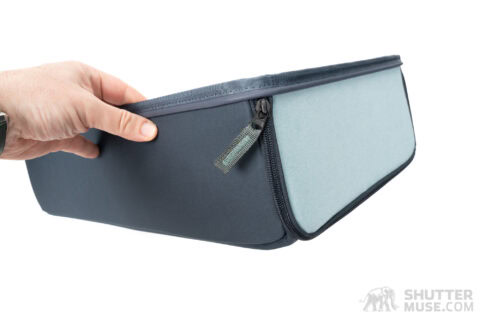


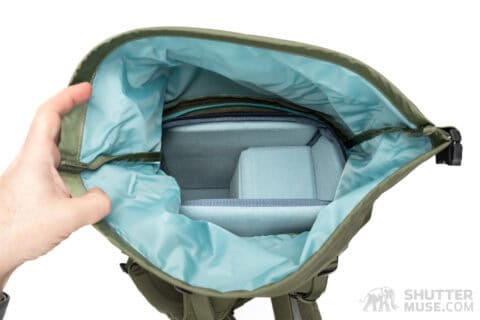


Which Core Units Fit Which Shimoda Bags?
Shimoda’s backpacks and roller bags are all compatible with the Core Unit system. Below you will find a list of all the bags and which Core Units will fit within them.
Explore Series
Before choosing a Core Unit for your Explore backpack, I recommend you read through our in-depth Shimoda Design Explore v2 backpack review. There is a lot of helpful advice that might influence your decision.
Core Units Compatible With Explore Original
- Explore 40 – XS25 / S25 / Medium Mirrorless / Large Mirrorless / Medium DSLR / Large DSLR
- Explore 60 – XS25 / S25 / Medium Mirrorless / Large Mirrorless / Medium DSLR / Large DSLR
Core Units Compatible With Explore v2
- Explore 25 v2 – XS25 / S25 / L25 RST*1
- Explore 30 v2 – XS25 / S25 / Medium Mirrorless / Large Mirrorless / L30 RST*1
- Explore 35 v2 – XS25 / S25 / Medium Mirrorless / Large Mirrorless / Small DSLR / Medium DSLR / Large DSLR / L30 RST*1
*1 – Fits, but top access is compromised. Not recommended.
Action X Series
I recommend reading our related Action X reviews before choosing a Core Unit for your Action X backpack. Thoughts on the 25L, 30L, 40L, and 50L sizes are covered in our Action X v2 review. With a slightly different set of features, I decided to cover the Action X70 HD in its own review.
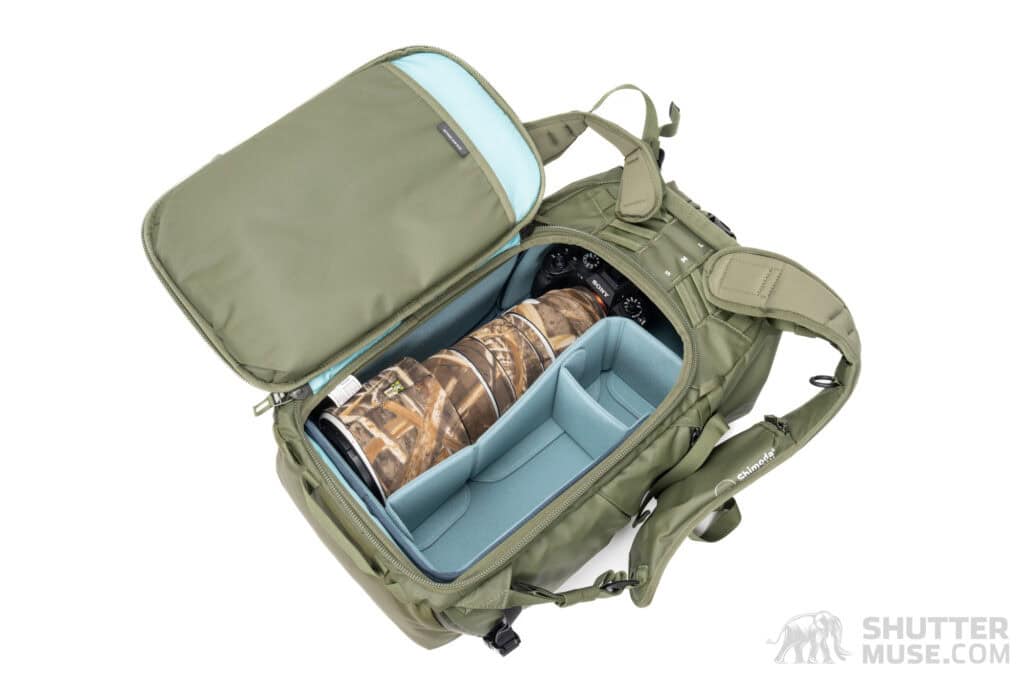
Core Units Compatible With Action X Original
- Action X30 – XS25 / S25 / Medium Mirrorless / Large Mirrorless / XL30 RST
- Action X50 – XS25 / S25 / Medium Mirrorless / Large Mirrorless / Medium DSLR / Large DSLR / XL40 RST
- Action X70 – XS25 / S25 / Medium Mirrorless / Large Mirrorless / Medium DSLR / Large DSLR / XL40 RST / XL50 RST / Large DV / Extra Large DV
Core Units Compatible With Action X V2
- Action X25 v2 – XS25 / S25 / L25 RST
- Action X30 v2 – XS25 / S25 / L25 RST / Medium Mirrorless / Large Mirrorless / XL30 RST
- Action X40 v2 – XS25 / S25 / L25 RST / Medium Mirrorless / Large Mirrorless / XL30 RST / Medium DSLR / Large DSLR / XL40 RST
- Action X50 v2 – XS25 / S25 / L25 RST / Medium Mirrorless / Large Mirrorless / XL30 RST / Medium DSLR / Large DSLR / XL40 RST / XL50 RST
- Action X70 HD – XS25 / S25 / L25 RST / Medium Mirrorless / Large Mirrorless / XL30 RST / Medium DSLR / Large DSLR / XL40 RST / XL50 RST / Large DV / Extra-Large DV / Extra-Extra-Large DV

Urban Explore Series

The Shimoda Urban Explore backpack is available in three sizes: UE20, UE25 and UE30. Unlike the Shimoda Explore and Action X series, the Urban Explore backpacks have a removable padded camera cube explicitly designed for those bags. Buying the Urban Explore backpacks in a “shell only” format is not possible. Since they come with their own custom-fit Core Units, Shimoda doesn’t advertise using any standard Core Units in the Urban Explore backpacks. Still, it is technically possible in the two larger sizes, so I include the details for completeness, although I fully expect this to be an outlying use case. For more details on Urban Explore bag, check out my review.



- Urban Explore 20 – Too narrow to hold any Core Unit other than the custom one it comes with and the XS25.
- Urban Explore 25 – Fits the XS25 Core Unit, and you can just about squeeze the S25 in, too. However, I don’t recommend it since it’s only a half-inch bigger than the dedicated Core Unit that the bag comes with. L25 RST also fits, but top access is compromised and not recommended.
- Urban Explore 30 – XS25, S25, M, and L Mirrorless Core Units will fit in this bag. There is some overlap with the bag’s included Core Unit. L30 RST also fits, but top access is compromised and not recommended.
Shimoda Roller Bags


Compatible Core Units
- Carry-On Roller v1 – XS25 / S25 / L25 RST / Medium Mirrorless / Large Mirrorless / Medium DSLR / Large DSLR
- Carry-On Roller v2 – XS25 / S25 / L25 RST / Medium Mirrorless / Large Mirrorless / Medium DSLR / Large DSLR
- DV Roller – XS25 / S25 / L25 RST / Medium Mirrorless / Large Mirrorless / XL30 RST / Medium DSLR / Large DSLR / XL40 RST / Large DV / Extra Large DV
Side Series

The Shimoda Side Series bags are designed to be used with the three sizes of Shimoda Top Loader, not the standard Core Units. Unlike Action X and Explore Series backpacks, the Side Series packs do not feature a zippered back panel. Although they have a side access door, and you might be able to use it with a Core Unit that also has a side access hatch, the depths of the Core Units do not perfectly match the depth of the Side Series bags. Most of them fit somewhat loosely, which can cause contents to slide out if the rest of the bag isn’t packed tightly.
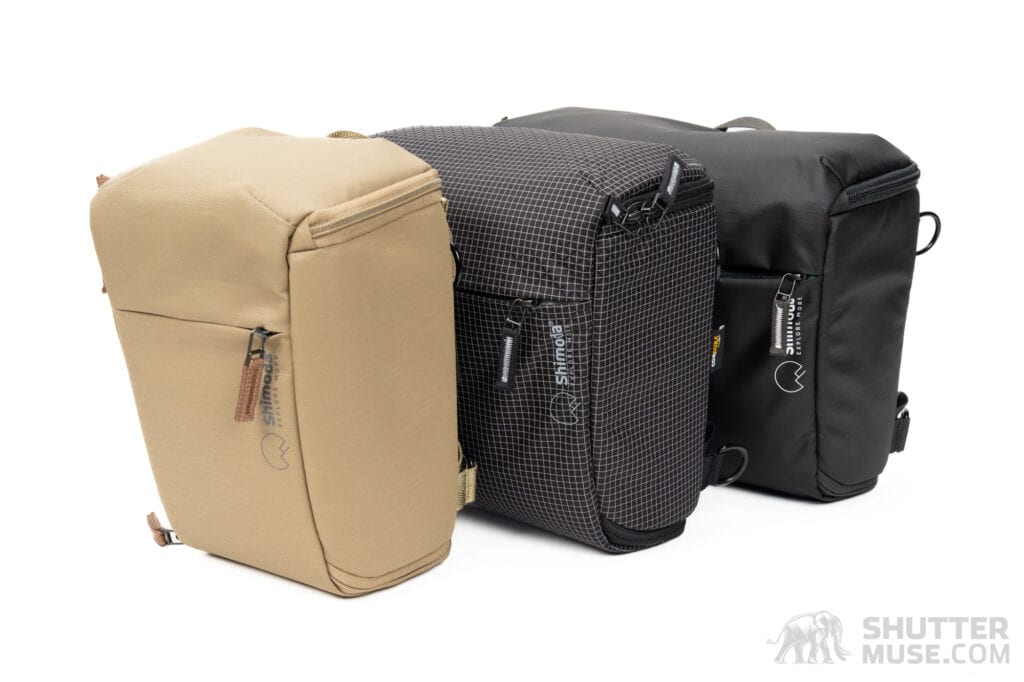
I tested all the Core Units with the Side Series bags and found only one that made any sense: the XL30 RST in the 32L Sidecountry pack. This was a near-perfect fit, and allows you to extract a large telephoto lens like a 200-600mm vertically from the pack’s roll-top, while accessing a second shorter telephoto, like a 70-200mm, through the side hatch. That said, it provides a similar amount of usable space to using the L25 RST in an Action X25 pack, demonstrated in this article, so you’d have to have a good reason for choosing the Sidecountry pack instead of that one.
Soft Cores

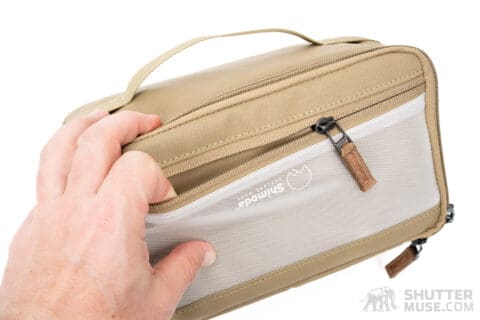




Shimoda’s Soft Cores are available in three sizes: Small, Medium, and Large. They offer soft-sided, thickly-padded protection for compact camera kits, photography accessories, and content creation kits that include microphones, action cameras, and pocket gimbals. Soft Cores are not explicitly designed for Shimoda camera bags. Instead, they can be squeezed into any camera bag or travel duffel. That said, I will note that the Large Soft Core is a perfect fit in the top section of an Action X40 or X50, and the Small Medium is the ideal fit in the top of an Action X25 or X30. Read my Shimoda Soft review here.
Drone Cores

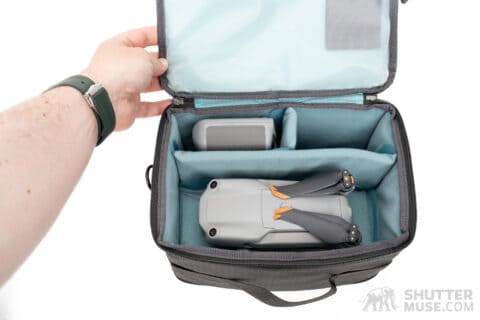




Shimoda’s Drone Cores are available in two sizes: Mini and Pro. They offer soft-sided, thickly-padded protection for most sizes of drones and auxiliary equipment and accessories. Unlike the standard Core Units, the Drone Cores are not explicitly designed for use with Shimoda backpacks. However, they are a perfect fit in the top section of the Action X40 and X50, and can be used in most other Shimoda bags when fitted into the main compartment. Unlike the Soft Cores, the Drone Cores come with a padded shoulder strap. Read my Shimoda Drone Core review here.
Core Unit Filter Pocket

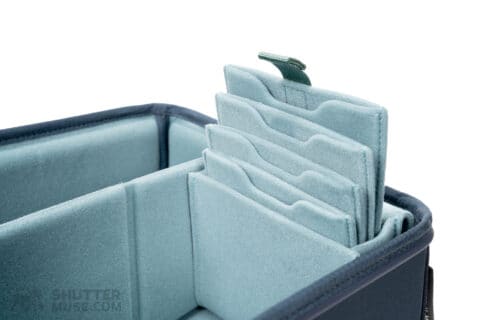

The Core Unit Filter Pocket is an optional extra, perfectly designed to pair with Shimoda’s standard Core Units, and secures using hook-and-loop fasteners. The Filter Pocket holds up to four 100mm filters in a retractable case. If you’re a landscape photographer with a few NDs or polarizers, this case offers great protection and a clever design.
Where to Buy + Save 10%
Shimoda Designs has offered Shutter Muse readers a 10% discount on anything purchased through their online stores. US, Canadian, UK, French, or German residents should use the discount code ShutterMuse10 after clicking here to access the store. Australian readers should use the same code on the local Shimoda distributor’s site, Maxxum, instead.
I recommend shopping directly with Shimoda, if you can, to take advantage of that 10% discount. However, using one of our other links is always appreciated if you can’t do that.
Standard Core Units
- XS25 Mirrorless Core Unit – Shimoda / B&H Photo
- S25 Mirrorless Core Unit – Shimoda / B&H Photo
- L25 RST Mirrorless Core Unit – Shimoda / B&H Photo
- Medium Mirrorless Core Unit – Shimoda / B&H Photo / Amazon / Adorama / WEX (UK)
- Large Mirrorless Core Unit – Shimoda / B&H Photo / Amazon / Adorama / WEX (UK)
- XL30 RST Mirrorless Core Unit – Shimoda / B&H Photo
- Small DSLR Core Unit – Shimoda / B&H Photo / Amazon / Adorama / WEX (UK)
- Medium DSLR Core Unit – Shimoda / B&H Photo / Amazon / Adorama / WEX (UK)
- Large DSLR Core Unit – Shimoda / B&H Photo / Amazon / Adorama / WEX (UK)
- XL40 RST DSLR Core Unit – Shimoda / B&H Photo
- XL50 RST DSLR Core Unit – Shimoda / B&H Photo
- Large DV Core Unit – Shimoda / B&H Photo / Amazon / Adorama / WEX (UK)
- XL DV Core Unit – Shimoda / B&H Photo / Amazon / Adorama / WEX (UK)
- XXL DV Core Unit – Shimoda / B&H Photo / Amazon / Adorama / WEX (UK)
Soft Core and Drone Core Units
Frequently Asked Questions
- Which Core Unit For The Sony 200-600mm Lens?
- Which Core Unit for the Nikon Z 600mm f/6.3 Lens?
- Which Core Unit for the Nikon Z 400mm f/4.5 Lens?
- Which Core Unit for the Nikon Z 800mm f/6.3 Lens?
- Can You Use Third-Party F-Stop ICUs in Shimoda Bags?
- Will the New Wider v2 DV Core Units Fit in the Original Action X70?
- Can You Fit a 600MM Lens in a Shimoda Core Unit?
- Does the XXL DV Core Unit Fit in the DV Roller? Or Any Other Roller?
Which Core Unit for the Sony 200-600mm Lens?


This is a popular question, so I’m answering it with its own sub-heading to make it easier to find. Sony 200-600mm lens users will need an L25 RST, a Large Mirrorless Core Unit, an XL30 RST, a Large DSLR Core Unit, an XL40 RST, an XL50 RST, a Large DV Core Unit, or the XL DV Core Unit. To be very clear, the Sony 200-600mm lens does not fit in any of the medium-sized Core Units, even if you remove the camera body.

I suspect the choice will almost always be between the L25 RST, Large Mirrorless, XL30 RST, and Large DSLR Core Units. Although the lens does fit in the DV units, that would limit the pack choice to the Action X 70 HD or the DV Roller. Also, the Sony 200-600mm lens is swimming in the XL40 RST, XL50 RST, and DV units, so there is no real need to use those combinations unless you have another large piece of gear to fit in there.

When choosing between the Large Mirrorless and Large DSLR Core Units, I would always recommend the Large DSLR Core Unit for the Sony 200-600mm. When the V3 version of the Large DSLR Core Unit was launched, its length was slightly increased to fit the Sony 200-600mm lens better. The Large Mirrorless Core Unit length was not increased and remains a tight fit. Check my guide to camera bags and accessories for the Sony 200-600mm G lens for more information. The XL30 RST is a nice choice if you value top access to a camera with the lens attached, and it offers enough length to leave the lens hood attached.
Which Core Unit for the Nikon Z 600mm f/6.3 Lens?


The Nikon Z 600mm f/6.3 lens is one of my all-time favorite super-telephoto lenses. The weight-to-image quality ratio is unmatched and addictive. Of course, when I got mine, I tried all the different Shimoda Core Units to figure out the best option. The Z 600mm f/6.3 lens is too long to fit in a Medium Core Unit. You must choose the L25 RST, a Large Mirrorless Core Unit, an XL30 RST, a Large DSLR Core Unit, an XL40 RST, or an XL50 RST.
The Large DSLR Core Unit (V3 and above) is slightly longer than the Large Mirrorless Core Unit. This does deliver a slight functional difference. If you use a shorter third-party Zemlin lens hood with your Z 600mm f/6.3, you can leave it attached to your lens in the forward-facing shooting position if you opt for the Large DSLR Core Unit. The Large DSLR Core Unit will also accommodate a gripped or pro-sized body, which the Mirrorless Core Unit will not.
Choosing the Large DSLR Core Unit means the smallest pack you can choose is the Action X40 V2 or Explore 35 V2. If you choose the Large Mirrorless Core Unit, you can also use the Urban Explore 30, Explore 30 V2, and Action X30 V2. Of course, you could opt for even bigger Core Units or bags like the X50 of X70HD, but given the lens’ design ethos is “small and light,” I don’t see the point in using one of those much larger options. Check out my guide to Nikon Z 600mm f/6.3 compatible camera bags and accessories for more info.
If you value top access to the camera and plan to use an Action X series backpack, using the L25 RST in the Action X25 gives you an incredibly compact way to carry your 600mm lens. Alternatively, you can use the XL30 RST in the Action X30 if you need to take more gear besides your 600mm. The little 600mm PF is swimming in the XL40 RST and XL50 RST, so I can’t see many opting for these combinations.
Which Core Unit for the Nikon Z 400mm f/4.5 Lens?


The Nikon Z 400mm f/4.5 fits the Large Mirrorless Core Unit well. It fits comfortably with a camera body attached, and you can choose to leave the lens hood in the forward-facing shooting position to minimize setup time. Pairing the Z 400mm f/4.5 with this Core Unit means choosing the Action X30 V2 or the Explore V2 backpacks. I believe this to be the best solution for this lens unless you want to use a pro-sized or gripped body, in which case you have to move up to the Large DSLR Core Unit for the added depth, and, in turn, that means choosing from the Action X40 V2 or Explore 35 V2.
You can also opt for the Medium Mirrorless Core Unit. However, there isn’t enough room to leave the camera attached, so I don’t see this being an optimal setup. Using the Medium Core Unit doesn’t allow you to choose a smaller backpack since the Action X25 V2 and Explore 25 V2 are incompatible, limiting the reasons for making this sub-optimal choice.
If you want top access to the lens with a camera attached, you can also opt for the L25 RST Core Unit if you plan to pair it with the Action X 25 backpack. The XL30 RST, designed for the Action X30, is also a great option if you have a lot of other camera gear to carry besides your 400mm lens.
Which Core Unit for the Nikon Z 180-600mm Lens?
The Nikon Z 180-600mm lens is the same length as the Sony 200-600mm lens. I have both lenses at my office and confirm that my Core Unit advice for the Sony lens also applies to the Nikon 180-600mm. Eventually, I will get around to shooting some photos of this combination. For now, look at the photos of Sony’s 200-600 as a reference.
Which Core Unit for theCanon RF 200-800mm Lens?
The Canon RF 200-80mm lens is the same length as the Sony 200-600mm lens. I have both lenses at my office and confirm that my Core Unit advice for the Sony lens also applies to the Canon RF 200-800mm. Eventually, I will get around to shooting some photos of this combination. For now, look at the photos of Sony’s 200-600 as a reference.
Which Core Unit for the Nikon Z 800mm f/6.3 Lens?
The Nikon Z 800mm f/6.3 lens will fit into the v3 model of the Large DSLR Core Unit or the v2 model of the Large DV Core Unit. It will not fit into earlier versions of either of those Core Units. When placed in the Large DSLR Core Unit V3, a very small amount of the lens hood protrudes above the edge of the padded cube. However, this isn’t noticeable when wearing the pack as it gets absorbed into the padding of the laptop compartment. In the Large DV Core Unit v2, there is no protrusion.
For a better fit in the Large DSLR Core Unit, you can use the lower profile third-party lens hood for the Z 800mm, made by Zemlin Photo. I used one and reviewed it here, and it’s a worthy upgrade. Using the Large DSLR Core Unit means you can choose between the Explore 35 v2, Action X40 v2, Action X50 v2, or Action X70 HD packs. Choosing the deeper Large DV Core Unit means you can only select the Action X70 HD.
You must step up to XL40 RST, XL50 RST, or the XL DV Core Unit to keep a camera mounted to the Z 800mm lens. Both RST Core Unit models would be my pick of the bunch for the Z 800mm lens, as they allow top access to the lens with a camera attached while keeping the bag –action X40 or X50- within most airline carry-on regulations.
Choosing a DV depth Core Unit means moving up to the Action X70 HD pack. This is a big pack and may be more than some people want. Check my X70 HD review here for all the details. Choosing the Action X70 HD allows you to select an XXL DV Core Unit. The Z 800mm lens fits into the XXL DV with a body attached and the lens hood in place.
Can You Use Third-Party F-Stop ICUs in Shimoda Bags?
From a sizing standpoint, you could easily use third-party camera inserts in Shimoda bags. In particular, there is a close correlation between the sizing of the Shimoda Core Units and the F-Stop ICUs or Think Tank Stash Masters. First, determine which Core Unit would be ideal and then compare the measurements with the F-Stop or Think Tank cubes range. My F-Stop ICU guides and Think Tank Stash Master guides have all the dimensions you need.
Using a third-party camera cube might be useful if you come from using a different brand of camera bag to a Shimoda bag and want to save money. In that case, you can buy the Shimoda backpack shell and use your existing camera insert. The main problem is the lack of side zippers on most camera inserts from other manufacturers. If you want to use the side access hatch on your Shimoda backpack, you will need to stick to using Shimoda Core Units.
Will the New Wider v2 DV Core Units Fit in the Original Action X70?
The v2 versions of the DV Core Units expanded their width from 11.4″ to 12.2″. Some original Action X70 HD owners wonder whether these new units will fit in their bags. I tested this myself since I have both the original Action X70 and the newer Action X70 HD. I can confirm that the new v2 DV Core Units fit the original Action X70.
Can You Fit a 600mm f/4 Lens in a Shimoda Core Unit?


Yes, you can fit a 600mm f/4 lens in either the XL DV or XL40 RST Core Unit if you detach the camera body, or if you want to leave the camera body mounted to the lens, you can get the XL50 RST or XXL DV Core Unit. This works for the Canon RF 600mm f/4, Nikon Z 600mm f/4, and Sony 600mm f/4 GM. Choosing the XXL DV Core Unit gives you the option of top access to your 600mm lens with a camera attached.


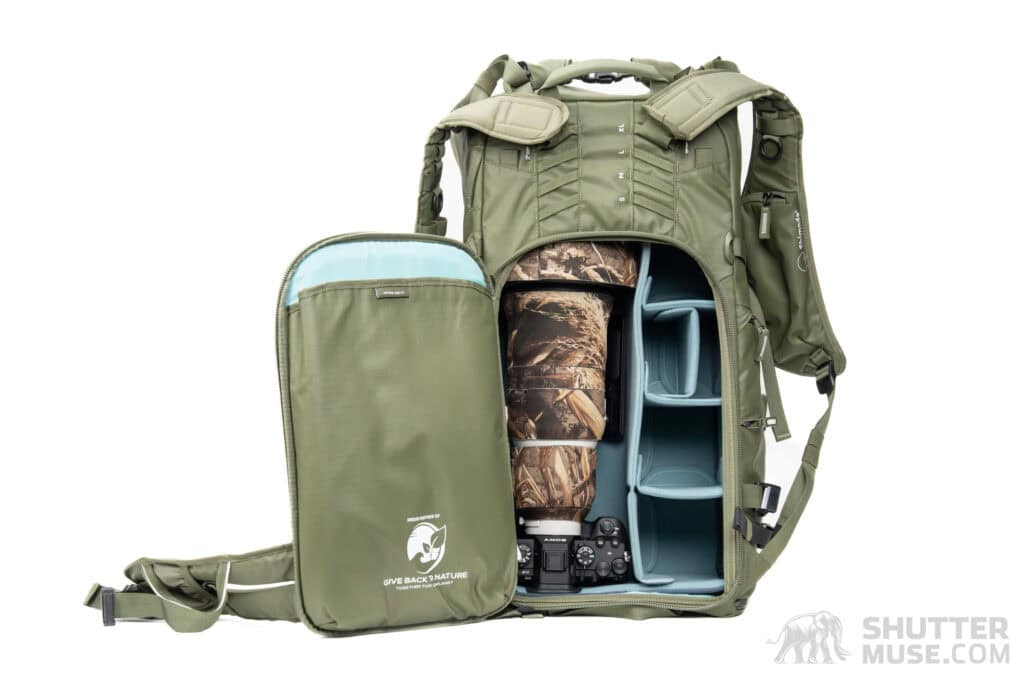
Does the XXL DV Core Unit Fit in the DV Roller? Or Any Other Roller?
Shimoda’s largest roller bag is the DV Roller, designed for the XL DV Core Unit. The XXL DV Core Unit does not fit in the Shimoda DV Roller. If you want a roller bag for the XXL DV Core Unit, buy the Pelican 1606 AIR roller. It’s a perfect fit.


















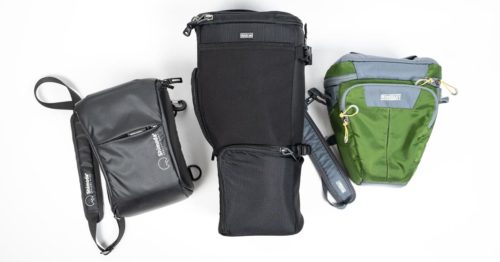
No link to click to get through to Shimoda Designs and benefit from the 10% discount
Hello
Does anyone know if shimoda’s core xl dv3 can fit a Sony 600 F4 from what I can see, there should be 1 cm left, but is it enough if there is a hood on 🧐
Yes, I believe that fits. If you want 100% confirmation, shoot them a message. Ian is very good with stuff like that.
Hi Dan, love your great reviews! I ordered my action x40 yesterday. Do you a best-practice or can share a picture on a good setup for the DSLR medium core unit for Sony‘s Holy Trinity (one lens is always mounted on a 7rIII)? I could not find any inspiration on this so far… Cheers! Tim
It would be great to read about the combination of core units that pack up the explore v2.
For example, the explore v2 35L comes with a medium DSLR core unit, but can I swap it out for two small mirrorless, or 1 medium and 1 small mirrorless ?
Hi Dan and thank you for all your articles about the Shimoda bags (and all the other bags), they are the best on the internet in my opinion.
I have a question about the Large Mirrorless Core Unit, if you don’t mind. The official specs say 12cm for the internal depth, but how much leeway there is in terms of depth if, for example I wanted to fit a Sony A1 body vertically, which is roughly 13cm? Is there a bit of space between the top of the core unit and the laptop compartment to fit something that is a bit taller, or is everything pretty much tight (also considering a latop in the sleeve that may invade that extra space a bit).
Looking at the internal dimensions specs of the Explore 30L and comparing it to the Large Mirrorless Unit, it looks like there should be a fair amount of extra space, but it’s hard to know for sure.
Thanks in advance!
There is some leeway because the laptop sleeve’s padding is pretty thick and squishy. I think you’ll be fine with a vertical a1.